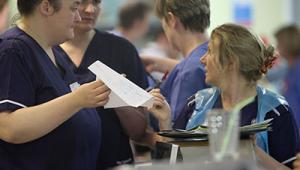In the document, published today, the House of Commons select committee on health calls the funding challenge facing the health service “colossal”. Moreover, while the committee acknowledged that spending was increasing, it warned the service is under unprecedented strain and struggling to keep pace with relentlessly rising demand.
In the Spending Review unveiled last November by then-chancellor George Osborne, the government promised an additional £8.4bn for the NHS above inflation by 2020-21. However, the report notes that unlike previous spending reviews, this figure related only to the budget of NHS England, rather than the whole of the Department of Health’s budget. This new measure leaves out, among other things, spending on public health, education and training.
If the previous definitions are used, and using 2015-16 as the base year, total health spending is set to increase by £4.5bn in real terms by 2021, rather than the £8.4bn originally mooted by Osborne.
Furthermore, the report warns that the funding set out in the Spending Review will not be sufficient to support the aims of the government’s Five Year Forward View published in October 2014.
Chair of the committee, Dr Sarah Wollaston MP, said: “While the NHS has been treated favourably compared to many other departments… funding cuts to public health will make it more difficult to address the challenge set out by the Prime Minister to reduce inequality.
“The cuts to public health education come at a time when the workforce shortfall is already placing a significant strain on services and driving higher agency costs. Training and developing the current and future NHS workforce must be a key priority for the NHS and we are deeply concerned about the effects of cuts to training budgets.”
She said the committee welcomed the upfront funding designed to speed up the transformation of services. However, she said, this cash had been used “almost entirely” to plug provider deficits, rather than “resource essential changes.”
She observed that short term measures were being used to deal with the worsening financial situation and capital budgets have been raided to meet spending, giving rise to the concern that the underlying financial problems facing the health service were being masked.
The report maintained that ongoing work to integrate health and social care services “showed great promise” but cautioned that integration and devolution did not offer quick solutions. Historical funding cuts have exhausted the potential for substantial further efficiencies in this area.
Richard Murray, director of policy at independent health charity The King’s Fund, praised the health committee’s “laser-like precision” in summing up the funding challenges facing health and social care.
He said: “The government must review its priorities for the NHS and be honest with the public about what the service can deliver with the funding it has been allocated.
“We note the committee has backed the independent assessment we and others made that the NHS budget will increase by much less than originally appeared in the Spending Review. We support their call for the government to return to using the previous definition of health spending.”
He also warned that there was no detailed plan for achieving the estimated £22bn budget shortfall and “no prospect that savings can be made at the pace or scale needed to meet this target.”
Paul Briddock, director of policy at Healthcare Financial Management Association, said: “Improving public health and prevention is a key part of reducing demand for hospital services, helping the service overall to meet the estimated funding gap of £22bn by 2020/21.”
Consequently, he agreed with the committee’s conclusion that cuts to public health funding were a false economy, because they were likely to create extra additional costs in the future. He also expressed concerns about how risk will be shared fairly across the various organisations, and called for complete transparency between commissioners and providers on how funding was distributed.
Overall, he said, “the situation has gone from bad to worse and there are growing concerns about the achievability of ambitions set out in the Five-year forward view.”



















